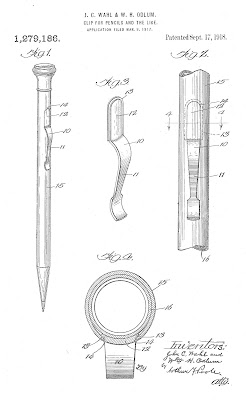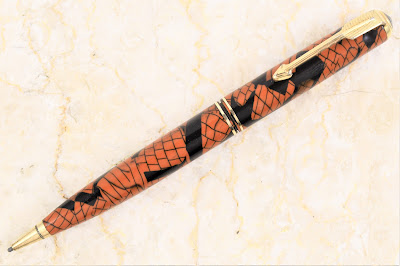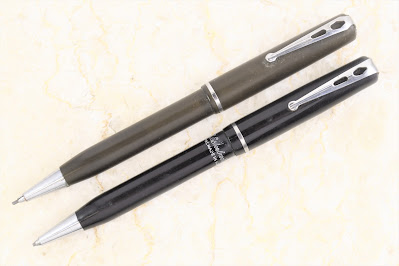This article has been included in The Leadhead's Pencil Blog Volume 7, now available here.
If you don't want the book but you enjoy the article, please consider supporting the Blog project here.
"The King of Pencils . . ." Charles Keeran used that slogan to advertise his new Ever Sharp back in 1914. It was just one example of Keeran's P.T. Barnum-style hyperbole -- however, his new pencils did trigger an industry-wide seismic jolt and singlehandedly standardized the size of ordinary writing lead to 1.1 millimeters in diameter.
Maybe Keeran was right.
His turn of phrase got me to thinking: out of more than 15,000 mechanical pencils in my collection, what would cause me to call just one pencil "the king" over all others?
I finally acquired something that I've chased for years, and as soon as I did, I had the title of this article in mind -- but for these last few weeks I've been turning the thought over in my head like pebbles in a rock tumbler . . . what elements of desirability, when they all swirl together into one perfect storm, would sift those 15,000 pencils down to the point at which I can truthfully say, "that one."
Rare . . . but not too rare
No pre-War pencils really fit the definition of "common," since even an ordinary Sheaffer pencil from the 1940s isn't something you'll trip over while walking out your front door every other Tuesday. However, in my hyperfocused world I'll admit I grow weary of seeing the same things scroll by in the online auctions, over and over again . . . and I grow wearier still of the sellers who persist in describing them as "rare." Perhaps what they mean is "undercooked."
However, after immersing myself in this microcosm I've created for more than two decades, the exercise of seeing so many examples of what I recognize as ordinary is what brings the extraordinary into sharp focus. This blog celebrates the things you don't see often . . . but it takes time and experience to recognize them. That "wow" factor causes me to buy box lots or even entire collections, just for that one pencil I haven't seen before.
Over the last decade, starting with The Catalogue of American Mechanical Pencils, more and more people are starting to see what I've seen all along. These days, I am competing for pencils rather than taking them off the hands of grateful pen collectors who didn't see much use in anything you can't fill with ink.
Here are some examples of rarities from the blog:
From top:
1. a Chilton "clown" pencil,
2. the Triad from Saturday's article,
3. an early Autopoint,
4. an Aikin Lambert "tree trunk" leadholder, and
5. the Heath snake pencil.
"They didn't just make one" has been my mantra whenever I have a chance to acquire things like these but the price is too high for my comfort. "They are like buses -- you can always wait for the next one" is something else I've also said more than once (most recently, just a couple days ago).
Sometimes, however, they did only make one, and when I know that's the case, I'll pay as much as I can get away with, bearing in mind the scrutiny that might result in the event the domestic finance committee might have dissenting votes should my investment be discovered. Prototypes or "shop pieces" are good examples, such as this collection of Ruxton Multi-Vider shop pieces, prototypes, paper ephemera, and production models, which surfaced in the hands of one of the heirs of Leonard G. Yoder, the Ruxton's shadowy man-behind-the-Ruxton in America (see Volume 4, page 351):
There's a problem when it comes to one-offs such as these: they can't sustain collector interest, because there is zero chance another collector would be able to acquire another example. The market for the only surviving example of anything is whatever that one owner is willing to accept in exchange for it . . . therefore, there is no market.
The "king" therefore would actually be an oligarchy of identical, yet impossibly rare examples. There must be enough to generate and sustain prices, so that when by chance one becomes available, the community at large takes notice of the price for which it changes hands and the price (if disclosed) sets the benchmark whenever the next one comes along.
Ingenuity
A pencil crowned "King" must have something unique about it which sets it apart from other pencils because of its design or function. Here are some good examples:
From top,
1. a General Manufacturing "Kaligraf" lever-operated pencil;
2. the weird Riedell,
3. a prototype Tri-Point from Edgar Nichols' estate,
4. an 1840s Addison with a perpetual calendar, and
5. a "Cranesharp" with its specially fabricated triangular lead.
The engineering that went into building these mouse traps elevates them above their contemporaries.
A Royal Name
All the pencils pictured so far have one thing in common: they don't bear the name of a manufacturer which is generally recognized outside of our circle of enthusiasts. Pencils from the "Big Four" manufacturers (Parker, Sheaffer, Eversharp, and Waterman) always have a leg up on lesser-known brands, because even people who know little or nothing about pencils will pay more for these than comparable (or even better) pencils just because of their name. Consider these:
From top,
1. the Parker Vacumatic in "cobra" or "eggshell",
2. the Sheaffer ebonized pearl golf pencil,
3. an early Heath-clip Ever Sharp (two words in the early days), and
4. the Waterman "Christmas" pencil bearing season's greetings from Frank D. Waterman.
A well-known manufacturer, like the other factors listed, will only go so far in ascending a rare variant to the level of King above all others. Each of these is rare, but who could say which Parker out of hundreds of models is the most rare and highly treasured Parker? Furthermore, even if the entire collecting community were to unanimously ordain any one Parker as the best out of all of them, who outside the walls of a pen show ballroom would readily take notice?
Crossover appeal
Many highly desirable writing instruments enjoy enhanced appeal because they are sought after by enthusiasts of different disciplines. Examples include these:
From top:
1. a Parker golf pencil sporting a Masonic imprint (Masons and Parker collectors want these),
2. an Eversharp "tree trunk" pencil (sought by Eversharp and Waterman collectors alike),
3. an Inkograph Mickey Mouse pencil (valued far more by fans of the mouse than fans of the pencils), and
4. a "sin" pencil (for fans of pencils, pens, gamblers, pin-up girls, and tobacciana . . . and aficionados of goofiness such as myself).
Intrinsic Value
The vast majority of writing instruments are made of plated ("filled," if heavily plated) metal; however, many manufacturers also turned out pencils made from solid gold, like these:
From top,
1. an Eversharp,
2. an Edward Todd calendar pencil,
3. a Rauch 1851 patent combination,
4. a Rauch based on Mabie's October 3, 1854 patent,
5. a Tamis watch pencil.
However, intrinsic value also has its limits in elevating a pencil's status in its claim to the throne. With the price of gold as high as it is, the intrinsic value of pencils such as these is often eclipsed by the value of the metal from which they have been fashioned.
Historical significance
A writing instrument's association with a person or its context within the history of American industry will often greatly enhance its value. One excellent example is this solid gold Sheaffer, engraved with Craig Sheaffer's signature and mounted on an autographed presentation card addressed to Edd Dawson, one of the early pioneers in pencil collecting:
The earliest American pencils, made in the 1830s and 1840s, provide insights into the development of the American pencilmaking industry during its infancy, their history is significant . . . but perhaps only within our community of enthusiasts.
From top:
1. an Addison,
2. a Hague,
3. a Rauch,
4. a Lownds, and
5. a Bard & Brothers (predecessor to Mabie, Todd & Co.).
On a larger scale, the nearly complete factory archive from the Dur-O-Lite Pencil Company, which I acquired in 2018, preserves the company's history:
Could any one pencil out of all of these single-handedly be declared King above all the others? One could spend hours debating the question of which of these is the best . . . which means no, none of them could.
Putting it all together
To be crowned King in a collection of more than 15,000 pencils, one piece must score highly on all fronts: it must be rare, with just enough surviving examples to establish a market; it must have some ingenious construction to grab a collector's attention; it must hail from a "royal" family, famed outside the world of pencils; it should have crossover appeal to collectors in other disciplines; it should have historic significance; and it should be made of some material other than plated base metal.
I can think of only one that checks off all these boxes:
This is the Metropolitan Life pencil, made by Tiffany to commemorate the completion of the Metropolitan Life Insurance Building in 1909 -- the tallest building in New York until the construction of the Empire State Building. This was the example in the KB Collection, and I took this picture in January of 2019 while I was previewing the KB Auction in Salisbury, England; I decided to shoot it resting in my hand, to give a sense of scale and the commanding presence it conveys in person.
Fortunately, I didn't travel to England solely to acquire this example -- I was there to chase the Heath snake pencil pictured earlier in this article. However, after luck went my way and the Heath was acquired for a pittance, I conserved all of my remaining budget to chase the Met Life.
Unfortunately, I learned just how desirable these are only after I had passed on several other reasonably priced items: the closing price on this pencil was some 3,500 pounds . . . plus auction premium, plus the 15 percent value added tax.
Other pencils in the auction sold for even more -- the Cartier in the immediately preceding lot went for some 7,000 pounds. However, (1) the Cartier was nondescript and ugly and (2) the closing price for the Met Life drew more surprised gasps from the audience . . . people knew it was important, but underestimated just how important.
I came home with the Heath snake and a picture of the Met Life in my hands, content but hoping someday I might get another chance at one for less than the price of a used car. Luck came my way at the Raleigh Show in June: Joe Nemecek had a spare. After he was convinced the example in his collection was lost forever, he tracked down a second example to replace it. When his original example finally resurfaced, he made me the offer of a lifetime: I could have his duplicate for what he paid for it.
No, I'm not going to tell you how much that was:
The pencil is housed in a box from the English house of Tiffany & Co., which is odd given that it commemorates a building in the ungrateful former colonies. The extender, however, it is marked with an American imprint, not English hallmarks:
The metalwork in sterling exquisitely and accurately replicates the architecture of New York's famous landmark:
There are just a handful of these pencils known to exist; rare but not too rare. The figural shape in combination with the surprise pencil inside gives it some ingenuity. The Royal name of "Tiffany" is known both in pencil collecting circles and is better known outside our circles than any of the Big Four. It has crossover appeal with those who collect and appreciate New York history and architecture as well as pencils. Its subject -- the Metropolitan Life Building -- has historic significance in celebrating the tallest building in New York until the Empire State Building was built.
The only pencil that might unseat the Tiffany Met Life pencil from the throne would be this same pencil, but in solid gold rather than sterling. To my knowledge, no such pencil exists.
Until it does . . . Long Live The King!




















































